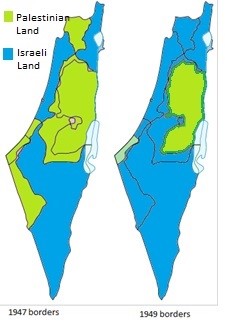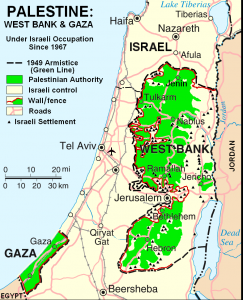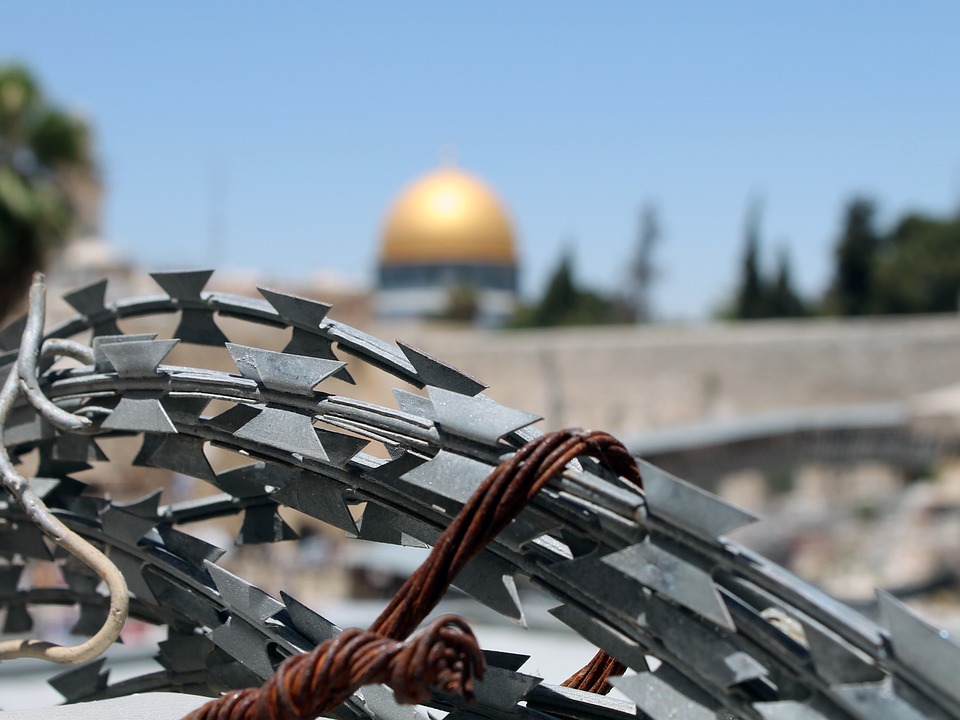The United States recently moved its embassy to Jerusalem, a highly controversial move which was part of the pre-electoral promises made by Donald Trump during his presidential campaign. Widely condemned globally, this action led to an uprising in Gaza, where more than 60 Palestinians were killed by Israeli forces.
There are few topics which raises more passionate opinions as the conflict between the Israelis and the Palestinians. Opinions are usually strong and set, and emotions run high. So what should be the Proutist view regarding this complicated conflict?
Before we can answer that, let us first take a step back in history and look at some of the background issues behind the conflict.
The Origins of Modern Israel
The kingdom of Israel can be traced back to the Iron Age (1200 – 500 BCE). According to the bible, Israel split into the kingdoms of Israel and Judea shortly after the reign of Solomon (estimated to 970-930 BCE). Israel was destroyed around 720 BCE by the Neo-Assyrian Empire. Judea was later conquered by Babylonian, Persian and Hellenistic empires but remained an autonomous Jewish province. In 110 BCE, a successful revolt led to the creation of an independent kingdom, but the independence did not last long. In 63 BCE the kingdom was invaded by Rome and became a client state. After unsuccessful revolts between 66 and 136 CE, the Jewish population was disseminated and scattered throughout Europe. Since then, up to the end of the First World War, when Palestine came under British control, the area has been controlled by Muslim rulers, apart for a short period during the Crusades when it was under European control.
Towards the end of the 19th century, the Zionist movement was born. This movement was aimed at creating a Jewish homeland for all Jews effected by the diaspora. Large groups of Jews gradually returned to what was to become Israel, and they started to actively pressure Britain to hand over the territory to them. The struggle was partly political, and partly physical, and even included what we today would describe as terrorist acts. In 1943, Yitzhak Shamir, who later became Prime Minister of Israel, wrote in the journals of Lehi, the terrorist organisation he headed, that terrorism is a legitimate weapon. “Neither Jewish morality nor Jewish tradition can be used to disallow terror as a means of war,” he wrote. He continued, “We are very far from any moral hesitations when concerned with the national struggle… First and foremost, terror is for us a part of the political war appropriate for the circumstances of today.”
The attacks were very effective, and included some of the worst terrorist incidents in the 20th century. Shortly after the end of the Second World War, Britain declared its intention to withdraw from Israel, as it saw no hope of finding a solution that would satisfy both Jews and Arabs. On November 29, 1947 the General Assembly of the United Nations agreed to a plan to partition Palestine into a Jewish and a Palestinian state, and on May 14, 1948, the State of Israel was declared.
The local Palestinian population, as well as the Arab neighbours, opposed the creation of Israel. In the ensuing war with Egypt, Syria, Transjordan and Iraq, which Israel won, over 80% of the Palestinian population fled or were expelled, and Israel expanded the original territory the United Nations had allocated the Jewish population with 60%. The remaining territory, which was supposed to constitute a Palestinian state, was divided by Egypt and Jordan. The 20% of Palestinians who remained became Arab citizens within the state of Israel.


The tension between Israel and its Arab neighbours after the 1947 war was never resolved. In 1967, Egypt blocked the straits of Tiran, a crucial shipping lane and Israel’s only access to the Red Sea, to Israeli shipping. This led to the second Arab-Israeli war, known as the Six Day War, which was also won by Israel. After the war Israel controlled the Gaza strip, the entire West Bank, Sinai as well as the Golan Heights. The Sinai was subsequently returned to Egypt following the Camp David Accords in 1978.
Over the years, numerous settlements have been created throughout the West Bank, and in reality the Palestinian Authority has now lost control over much of what was left of the West Bank. This is the current territorial situation.
Palestinian Resentment
As the original plan to partition the country into a Palestinian and Jewish state failed early on, it left the Palestinians in a very difficult position. Israel in reality took over all the land, both that land which was supposed to constitute the land of Israel, and the land that was supposed to be owned and ruled by the Palestinians. With most of the Palestinian population today living as refugees in their own land, their desire to live and rule in their home land is very strong. Many different political and military movements has arisen among them, such as the Palestinian Liberation Organisation (PLO), Hamas, Palestinian Islamic Jihad and the Popular Resistance Committees. The aim of these organisations were to take back all land originally belonging to Palestinians, and, as Yasser Arafat put it, “the uprooting of the Zionist entity from our land and liberating it.”
As part of its struggle to regain Palestinian land, terrorist tactics were used by the Palestinians to attack the civilian population inside and outside Israel. The 1972 attack on the Israeli Olympic team in Munich, perpetrated by the PLO subgroup Black September, where 11 Israeli athletes were killed, was one of the most publicised attacks outside the Middle East. The violence has continued up to present time, with hijacking of aircraft, suicide bombings, stabbings, etc. Since the formation of Israel, it is estimated that close to 3,000 people have been killed by Palestinian terrorist attacks.
Israeli Response
The Israelis did not take these issues sitting down; they have used any possible means to fight back. The first hijacking of an airliner in the Middle East was orchestrated by Israel in 1954, in order to take hostages to negotiate the release of Israeli prisoners held in Syria captured on a spy mission. In 1973, Israel shot down a Libyan airliner on its way to Cairo, killing 110 people on board. The same year they attacked Tripoli in northern Lebanon, killing 31 people and destroying classrooms, medical clinics and other buildings. There was no pretext of self-defence, and the attack was justified as being pre-emptive.
Israeli rule in the occupied territories is also brutal. Based on the findings of the International Committee of the Red Cross in Geneva—which is mandated to oversee that the Geneva Convention is upheld in the Israeli Occupied Territories of the West Bank and Gaza—Israel has been violating almost every major provision of the Convention, such as deportations, destruction of civilian homes, assassinations, torture, kidnappings, etc.
Violence is obviously used to terrorize people on both sides of the conflict. But since Israel has more power at its disposal, its capacity for violence is greater than that of the Palestinians. According to the Israeli Information Center for Human Rights in the Occupied Territories, from 2009 to 2018, the number of Palestinians killed by Israelis outnumbered Israelis killed by Palestinians 27 to 1.
Where to Go From Here?
Some observers think that Israel will eventually annex the occupied territories and deny citizenship to the Palestinian population living there. This is obviously not a solution and would simply intensify the struggle. Conversely, the original Arab idea of ‘uprooting the Zionist entity’ and destroying Israel is also non-starter—it will never happen.
Apart from these two non-starters, there are three possible solutions for resolving the Israel-Palestinian conflict.
The Two State Solution
The original idea was to create two countries, Israel and Palestine, co-existing side by side and both having viable international borders. The PLO have in principle accepted this solution using post-1949 borders to demarcate two states. The United Nations approved this solution, but left the negotiations of the specific borders in the hands of the Israelis and the Palestinians. A two state solution is the outcome favoured by the majority of both Palestinians and Israelis.
The problem with this solution, even if it would be accepted, is that Palestine would in effect be split in two. The main portion would be land locked, and the Gaza strip would be too small to function as an effective economic unit. While the original borders set up for Palestine were viable, the existing ones are not. The Palestinians would in effect be totally dependent on Israel for its economic survival.
But it gets worse. While it is certain that Israel will never accept the original partitioning plan agreed to by the United Nations in 1947, they will clearly not accept the 1949 borders either. Israel have actively supported Jewish settlements in the West Bank, and they are now so widespread that they crisscross the entire occupied territory. Unless Israel is willing to abandon all these settlements, which is very unlikely, there is no unified piece of land left to form a Palestinian state.
A Three State Solution
Since neither the Gaza strip nor the West Bank can become viable states, it has been suggested to let the Gaza strip return to Egypt and the West Bank to Jordan. But this ‘solution’ would probably create more problems than it will solve. The Palestinians would be deprived of a land they could call their own, and their fight for a homeland would continue. Even Jordan is unlikely to agree to this solution, as it has no interest in getting more deeply involved in the conflict.
The One State Solution
The one state solution advocates one single state comprising Israel, the West Bank and the Gaza strip, with equal citizenship and equal rights to all citizens regardless of ethnic or religious affiliation. While some rightist parties in Israel support a one state solution, others fear that Jews will become an ethnic minority in the only Jewish state in the world.
Still, this solution is attractive as it could create a modern, secular state not guided by religion, where all people living within its borders have full and equal rights. This is the solution proposed in the manifesto of Universal Israel, the Israeli samaj movement.
A Proutist Perspective
This is no doubt a very complex issue, and to come up with a simple solution is difficult. But looking at it from the perspective of Prout may help us to understand the problem better.
It seems obvious that both Jews and Palestinians can claim the land to be theirs, as they both have a long history in the region. Therefore, for a final solution to appear, the interest of both peoples have to be respected.
If we look at the area from the prospect of a Samaj, the respective socio-economic areas would need to be economically viable. The original division conceived by the United Nations made two viable nations. As the culture, language and sentimental legacy of Jews and Palestinians are different, two viable Samajas in the form of nation states would have been a good option.
However, with the current expansion of Israeli territories and Jewish settlements in the West Bank, no viable Palestinian Samaj could be created, regardless of the sentimental legacies involved. The current situation, where Palestinians live under Israeli occupation without any rights at all, is the worst possible solution. Unless Israel agrees to return to the 1947 borders, or at least cedes enough land to create an economically viable Palestinian state, a one state solution where all inhabitants, whether Jews or Palestinians, are equal citizens with the same rights seems the best compromised solution we can hope for in the region.
I will return to this topic in a later piece to expand on this idea.
While the relocation of the American Embassy from Tel Aviv to Jerusalem is, no doubt, a provocative move, it will probably have little practical effect on the final outcome of the conflict.


Thank you for this unbiased and honest assessment